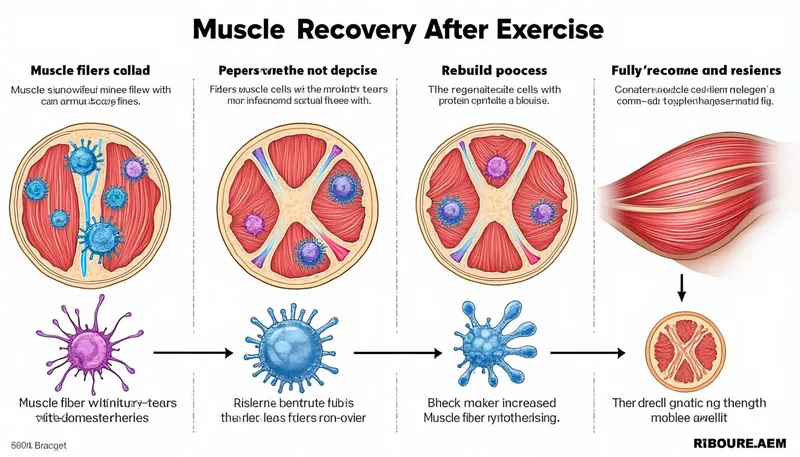When it comes to fitness and building muscle, many often focus on how hard they can push their bodies in the gym. But here’s the kicker: the real secret to gains isn’t just about how hard you train, but rather how well you can recover. Understanding muscle recovery is vital for optimizing performance and achieving your fitness goals. Whether you’re a seasoned athlete or just starting out, recognizing how much rest your muscles really need makes all the difference. Recovery isn’t merely a fleeting concept; it’s an ongoing process that plays a crucial role in muscle repair, growth, and overall fitness. So, let’s dive in and explore the various facets of muscle recovery!
Brief
- Muscle recovery is just as critical as the workout itself 💪
- Factors affecting recovery include age, workout intensity, and nutrition 🥗
- Rest periods can vary from 24 hours to a week depending on workout intensity ⏳
- Muscle soreness tends to peak 24-72 hours post-exercise 🔄
- Listening to your body is key! 👂
Understanding the Basics of Muscle Recovery
Muscle recovery is the body’s ability to restore itself after a taxing workout. It involves cellular repair processes and the replenishment of energy stores depleted during exercise. During intense training, muscle fibers experience microscopic tears, which is a normal part of muscle development. However, for your body to rebuild these fibers stronger, it requires adequate recovery time.
The 24 to 72-Hour Rule
Depending on the intensity of your workouts, muscles typically require 24 to 72 hours to recover fully. This time frame allows both the physical muscles to mend and your nervous system to recuperate. For instance, a light workout, such as low-intensity cardio, might only necessitate a 24-hour rest period. In contrast, strength training or high-intensity interval training (HIIT) can demand closer to 72 hours of recovery time.
Here’s a quick breakdown of recovery times based on workout intensity: 💡
| Workout Intensity | Recommended Recovery Time |
|---|---|
| High-Intensity Workouts | 48-72 hours |
| Moderate-Intensity Workouts | 36-48 hours |
| Low-Intensity Workouts | 24 hours |
As you embark on your fitness journey, being attuned to the signals your body sends is paramount. Factors such as muscle soreness, fatigue, and overall performance can indicate whether you require more time to recover. Deload weeks, which involve deliberately reducing workout intensity or volume, can also serve as a useful strategy for allowing your body to catch up.

The Role of Sleep and Nutrition in Recovery
While time is a critical factor in muscle recovery, it’s essential to recognize the role of sleep and nutrition as well. During sleep, growth hormone levels peak, facilitating muscle growth and repair. Without adequate sleep, you may hinder your progress and increase your chances of burnout.
- Nutrition: Proper nutrition fuels the recovery process. Post-workout meals rich in protein help rebuild muscle fibers. Aim for a meal containing both protein and carbohydrates within 30 minutes of your training session.
- Hydration: Staying hydrated is equally vital. Water is crucial for muscle function and aids in transporting nutrients throughout the body. Dehydration can increase recovery time and lead to further complications.
- Supplements: Some may benefit from incorporating recovery supplements such as branched-chain amino acids (BCAAs) or protein powder to aid recovery. Consider products like RecoveryPro or MuscleMend for additional support.
Recognizing the Signs of Overtraining
Overtraining is an all-too-common issue among fitness enthusiasts. It occurs when there’s an imbalance between training and recovery, leading to persistent fatigue, decreased performance, and potential injury. Recognizing the signs of overtraining can help prevent setbacks in your fitness journey.
Here are common signs of overtraining to watch out for: ❗
- Chronic fatigue or lethargy 😴
- Increased muscle soreness or prolonged recovery time 🦵
- Elevated resting heart rate ❤️🔥
- Declining performance despite increased effort 📉
- Motivational decline or persistent anxiety related to workouts 😨
Understanding the importance of rest and recognizing the symptoms of overtraining can help maintain a balanced routine. Strategies like incorporating rest days, reducing workout duration, or even performing active recovery can make significant differences in your performance and overall health.
Active Recovery Techniques
Active recovery involves low-intensity exercises like walking, yoga, or swimming, which can enhance blood flow and promote muscle recovery without exerting significant strain. These activities stimulate circulation, helping to remove metabolic waste products, such as lactic acid, and promoting nutrient delivery essential for healing.
| Active Recovery Activity | Benefits |
|---|---|
| Walking | Enhances blood flow and reduces stiffness 🚶♂️ |
| Yoga | Improves flexibility and reduces tension 🧘♂️ |
| Light Swimming | Offers a low-impact workout while building endurance 🏊 |

Personalizing Your Recovery Plan
Creating a tailored recovery plan accounts for individual factors such as age, training history, and fitness goals. Younger individuals tend to recover more quickly than older adults. Furthermore, those focused on building strength might require extended recovery periods compared to those concentrating on endurance.
Here’s how you can personalize your recovery plan: 🔑
- Evaluate Your Training Pattern: Assess the frequency and intensity of your workouts. Strength training sessions may usually necessitate longer recovery times compared to lighter cardio sessions.
- Listen to Your Body: Your body is your best indicator. If you feel sore or fatigued, take a day off or switch to a lighter training mode.
- Use Recovery Tools: Consider utilizing tools like massage guns or foam rollers to enhance muscle relaxation.RestWell products can also aid recovery.
Remember, the goal is to maximize gym performance while promoting a sustainable fitness lifestyle. Clarity about your personal recovery needs can propel you toward your fitness aspirations.
Tips for Optimal Muscle Recovery
To achieve the best possible recovery from your workouts, implementing some pro tips for muscle recovery is essential. With strategies like those outlined below, you can maximize your gains while minimizing the risk of injury or fatigue.
Check out these effective muscle recovery tips: 📌
- Incorporate rest days into your weekly fitness schedule to allow adequate recovery.
- Consider active rest days to promote blood flow and reduce stiffness.
- Utilize cold water immersion or contrast baths to alleviate muscle soreness.
- Ensure your nutrition is balanced, with adequate protein, carbs, and healthy fats.
- Use mental relaxation techniques such as meditation to reduce stress, which can inhibit recovery.
| Recovery Tip | Description |
|---|---|
| Rest Days | Key for muscle mending and overall fitness improvement 🛌 |
| Active Rest | Low-impact activities to stimulate recovery without excess strain 🏃♀️ |
| Nutritional Support | Food and supplements aid in muscle repair and energy replenishment 🍽️ |
How long do I need to rest after a workout?
Rest periods typically range from 24 to 72 hours depending on workout intensity.
What factors affect recovery time?
Factors include workout intensity, age, training history, and overall nutrition.
What are the signs of overtraining?
Signs include chronic fatigue, elevated heart rates, and prolonged muscle soreness.
Can I recover faster with supplements?
Certain recovery supplements can assist but are not a replacement for proper rest and nutrition.
How can I personalize my recovery plan?
Consider your workout intensity and duration, track how your body feels, and adjust rest periods accordingly.


